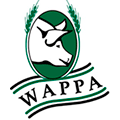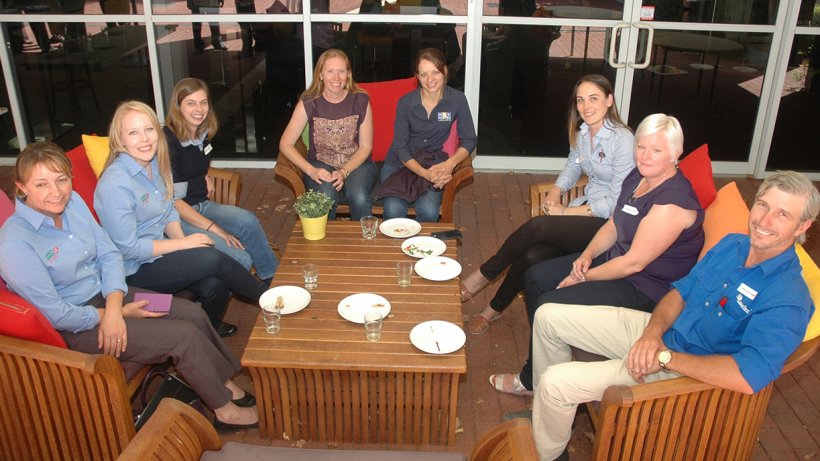 Attended by about 100 people at Technology Park, Bentley, it was hosted by West Australian Pork Producers Association (WAPPA) and sponsored by Pork CRC, APL, MSD Animal Health, Elanco and Zoetis.
Attended by about 100 people at Technology Park, Bentley, it was hosted by West Australian Pork Producers Association (WAPPA) and sponsored by Pork CRC, APL, MSD Animal Health, Elanco and Zoetis.
After a revealing presentation on post cervical artificial insemination by Dr Vanessa Morris of Portec Veterinary Services, Portec Principal Dr Kim Nairn built on his 2016 talk on biosecurity by running through a list of emerging on-farm health issues.

He warned of the threat posed by unwanted waterbirds, especially ducks, when their faeces could contaminate pig feed and subsequently infect pigs with salmonella. The risk was magnified in the increasingly popular free range and ecoshelter systems, which offered unwanted intruders relatively easy access to pig feed and pigs.
Avian influenza and swine dysentery were other threats, along with mycotoxins from grain and straw harvested in wet conditions.

Having just returned from animal science meetings in Des Moines, USA, Pork CRC CEO Dr Roger Campbell revealed that the six million sow US industry was growing quite rapidly in terms of production and packing plants, with domestic demand increasing slower than population growth, which meant additional production had to be exported. Currently about a quarter of production is exported.
“Trends apparent during my visit were continual improvement in reproduction, more judicious use of antibiotics, largely being driven by veterinarians and piggery disease loads remaining high for porcine reproductive and respiratory syndrome and swine influenza virus and, to a lesser extent, porcine epidemic diarrhoea virus,” he said.
Turning his attention to Australia, Dr Campbell said the position for Australia’s pork producers was changing and challenging, with their future dependent on how much further price slipped and how well they managed cost of production.
General Manager Policy with Australian Pork Limited, Deb Kerr, updated attendees on a range of industry statistics, including: national slaughterings up 11% in January 2017 on January 2016, resulting in national meat production rising by 14% on January 2016; breeding herd and fresh pork per capita consumption continuing to increase.
She also announced that an additional $964,000 had been committed nationally to market the versatility of pork, with WA’s share commencing with a roast promotion in April and the WA campaign concluding at the end of June.
WAPPA Executive Committee member Dean Romaniello, a senior manager with Linley Valley Pork, generated a spirited debate when he introduced and addressed his agenda topic ‘fit to load and abattoir protocols’.
A few producers vigorously debated perceived issues surrounding the new meat notice issued by the Australian Government’s Department of Agriculture and Water Resources. Covering animal welfare concerns at export registered pork slaughtering establishments, it was, effectively, unveiled at the Pig Day Out by veterinarian Dr Ran Tal, Area Technical Manager, Meat Exports Branch, with the Department.
Dr Tal did his best to answer the many queries fired at him, as did DAFWA Senior Compliance Officer Alex Stewart, a 38 year DAFWA veteran based at Narrogin.
Much less controversial was an update on the research activities of Pork Innovation WA delivered by Emalyn Loudon, PIWA’s secretary/treasurer and a WAPPA Executive Committee member.
Aside from finalising Pork CRC and APL projects PIWA inherited from DAFWA in June last year, its most significant new project hopes to establish WA as the Australian centre for the production of high quality free range pork.

The two and a half year project will specifically tackle cooling system design for farrowing huts and nutrition protocols for supplementing essential fatty acids and betaine in lactating sows and develop a management toolkit for free range operatives.
PhD candidate Karen Moore of PIWA addressed the topic of optimising production of male pigs using Improvac, admitting that summarising six years work into six minutes was a difficult task.
Her key take-home messages were: most fat deposition occurs in the second two week period after the second dose of Improvac; Improvac males should be fed the same level of SID lysine as entires for two weeks after the second dose and following this the SID lysine should be decreased; light entires can still have boar taint; mineral salts reduce feed intake and improve FCR, but have no effect on backfat or whole carcase fat; albus lupins may reduce feed intake, improve FCR and reduce backfat.
Pig Day Out final speaker, Crawford Taylor, WA Manager, Food and Agribusiness with Rabobank, unveiled his crystal ball to deliver a measured commodity outlook: world economy to improve in 2017; grains, oil and freight see price improvement, but only limited recovery due to significant stock and capacity overhang.
Mr Taylor said the USA was expanding pork production, with a forecast three per cent growth and, in the process, bringing five new plants online in next two years.
China’s domestic pork production was expected to rebound by two per cent in 2017, while the EU’s was tipped to decline by 1.5 per cent.
Speaking after a very successful Pig Day Out, WAPPA President and Popanyinning producer Dawson Bradford said highlights were the robust discussions on all topics, but especially the hot button issues of animal welfare and codes of practice and the attendance of Year 11 students from Bindoon Catholic Agricultural College.
“As we continue to grow our industry in WA, our future is increasingly dependent on developing, nurturing and accessing an available pool of quality, committed piggery staff,” Mr Bradford said.
“We therefore encourage secondary and tertiary students to seriously consider making their careers in WA’s pork industry and WAPPA commits to helping ensure pathways are both accessible and attractive.”
WAPPA’s Executive Committee comprises Dawson Bradford (President) of Popanyinning, Graeme Dent (Vice President) of Cuballing, Torben Soerensen (Treasurer) of GD Pork, Dean Romaniello of Craig Mostyn Group and Emalyn Loudon, consultant to the pork industry.
March 30, 2017 - West Australian Pork Producers Association


